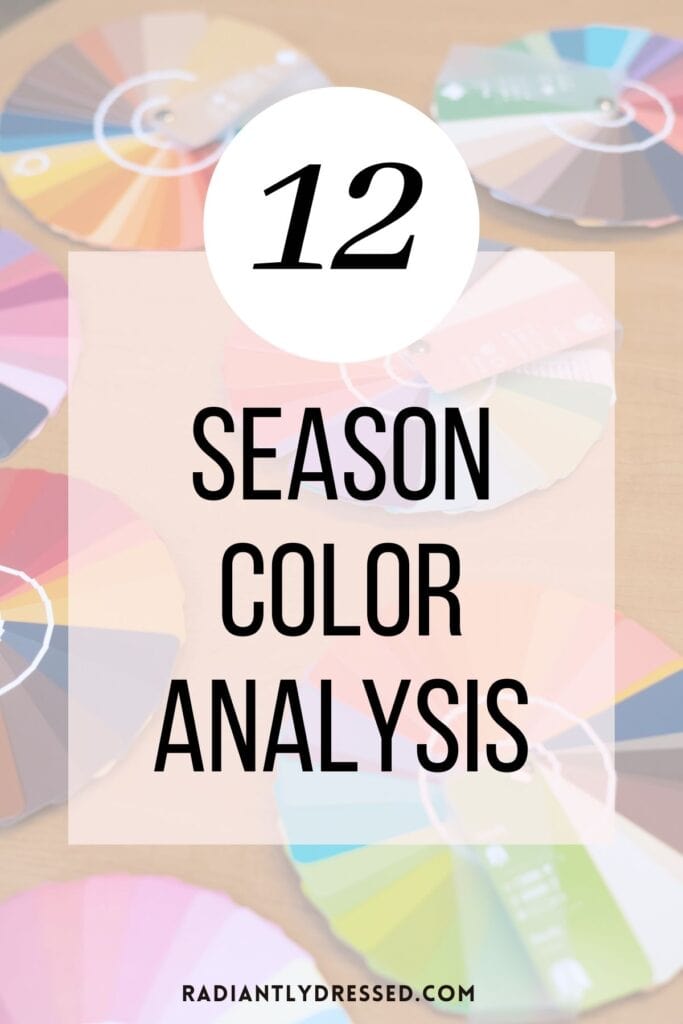Here at Radiantly Dressed we use the classic 12 season system of color analysis.

Color analysis is a powerful tool that helps you identify the ideal color palette for your wardrobe based on your natural coloring. In the 12 season color analysis, your complexion, hair, and eye colors are matched to one of 12 distinct color palettes, each representing a season. This approach is a more refined version of the classic 4 season color analysis from the 80s, offering a broader range of hues, values, and chromas to better suit individual unique colorings.
Understanding your color season can significantly improve your look, ensuring your clothes and accessories enhance your natural beauty rather than detract from it. The 12 seasons are based on the flow theory, which emphasizes the gradual transition of colors from one season to another. By determining your dominant season and utilizing its colors, you can elevate your style and boost your confidence with tailored color choices.
Key Takeaways
- Color analysis identifies the ideal color palette for your wardrobe based on your natural coloring
- The 12 season color analysis provides a more refined approach than the classic 4 season method
- Understanding your color season enhances your appearance and offers a personalized style
Fundamentals of Color Analysis
History of Color Analysis
The concept of color analysis started in the 20th century with the work of artists and designers who observed how certain colors could enhance or detract from a person’s appearance. Over time, this idea evolved into a systematic approach to identifying which colors look best on an individual based on their natural coloring. As you explore the history of color analysis, you’ll find that it has come a long way since its inception, now offering more precise guidance for the perfect color combinations.
The Four Seasons Color Theory
The four seasons color theory is a popular and straightforward method for determining which colors work best for you. In this system, individuals are classified into one of four categories—Spring, Summer, Autumn, or Winter—based on their skin tone, hair color, and eye color. Each season represents a specific color palette tailored to enhance your natural beauty. For example:
- Spring: Light, warm colors with bright undertones
- Summer: Cool, muted colors with soft undertones
- Autumn: Deep, warm colors with rich undertones
- Winter: Bold, cool colors with sharp undertones
To find your season, analyze your hair, eye, and skin colors, considering their unique combinations of hue, value, and chroma. These individual aspects will guide you towards the season that complements your natural coloring.
Expansion to 12 Seasons
In an effort to provide a more customized approach, color analysis expanded from the original four-season system to the 12-season system. This advanced method delves further into the nuances of color by dividing each of the primary seasons into three sub-categories:
- Spring Subcategories:
- Summer Subcategories:
- Autumn Subcategories:
- Winter Subcategories:
Each of these 12 subcategories comes with its own color palette, providing you with an even more tailored spectrum to complement your unique combination of hue, value, and chroma. To find your specific subcategory, examine your hair, skin, and eyes using a more refined set of characteristics, including aspects like lightness and darkness, warmth and coolness, and clarity and softness. With this deeper understanding, you can further enhance your color analysis and make the most of your natural beauty.
The 12 Season Color Palettes
Spring Subseasons
In the Spring category, there are three subseasons to consider: Light Spring, Clear Spring, and Warm Spring. These palettes usually consist of vibrant, warm, and light colors that can bring out the warmth in your complexion.
- Light Spring: This palette contains soft, light shades with a warm undertone. Think of colors like light peach, golden yellow, and aqua.
- Clear Spring: Colors in this palette are clear, bright, and slightly warmer. They include shades like bright coral, turquoise, and jade green.
- Warm Spring: Predominantly warm tones such as golden brown, mustard, and deep turquoise can be found in this palette.
Summer Subseasons
The Summer season is characterized by three subseasons: Light Summer, Soft Summer, and Cool Summer. These palettes embrace the cooler, softer, and more muted colors that complement a summer skin tone.
- Light Summer: A blend of cool and light colors like lavender, soft pink, and pale blue make up this palette.
- Soft Summer: Muted, neutral shades, such as dusty rose, slate blue, and sage green, are found in this palette.
- Cool Summer: In this palette, cool, soft shades like periwinkle, mauve, and dusty blue are prominent.
Autumn Subseasons
Autumn’s color palettes feature warm, rich, and earthy tones that embody the changing of the leaves. The three subseasons are Warm Autumn, Soft Autumn, and Deep Autumn.
- Warm Autumn: This palette includes warm, golden shades like caramel, pumpkin, and olive green.
- Soft Autumn: Muted, earthy colors such as terracotta, moss green, and deep teal compose this palette.
- Deep Autumn: Rich, deep, and warm tones dominate this palette, with colors like burgundy, chocolate brown, and burnt orange.
Winter Subseasons
Lastly, the Winter season brings forth cool, deep, and contrasting colors. Its three subseasons are Cool Winter, Clear Winter, and Deep Winter.
- Cool Winter: Cool, icy tones like silver, plum, and royal blue define this palette.
- Clear Winter: With bright and pure colors, this palette showcases shades such as ruby red, emerald green, and sapphire blue.
- Deep Winter: This palette boasts deep, dark, and cool colors like charcoal, crimson, and dark purple.
By understanding your seasonal color palette, you can choose clothing, accessories, and makeup that best emphasize your natural beauty. Embrace the hues that harmonize with your complexion and enjoy the confidence they bring.
Determining Your Season
Self-Assessment Guidelines
When trying to identify your season, consider the following aspects:
- Undertones: Observe the undertones of your skin, hair, and eyes. They can be warm, cool, or neutral.
- Eye color: Your eye patterns can help narrow down your season. Here are some examples:
- Hair color: Your hair doesn’t feature in seasonal color analysis as much as in some other methods of analysis.
- Colors that suit you: Try different color swatches near your face and compare. Colors that fall within your season palette should flatter your complexion and brighten your appearance.
Professional Color Analysis
If you’re having difficulty determining your season or simply prefer expert guidance, consider scheduling a professional color analysis with a certified color consultant. The consultant will usually use draped color swatches under different lighting conditions to identify the colors that best suit your natural coloring.
A professional color analysis can offer customized advice and a detailed color palette, which can help you make informed decisions on clothing, accessories, and makeup.
Remember, understanding your season can greatly enhance your appearance, boost your confidence, and simplify your wardrobe choices.
Application of Seasonal Colors
Wardrobe Building
Determining your color season can significantly enhance your wardrobe. By focusing on the colors that complement your natural features, you’ll create a cohesive and flattering look. To start, identify your primary color palette by matching your skin, hair, and eye color to one of the 12 color seasons.
Once you have your palette, you can begin incorporating it into your wardrobe. Build a solid foundation with neutral colors from your season, such as blacks, grays, and browns. Then, start adding in accent colors from your palette for a more dynamic appearance. The goal is to create a wardrobe that:
- Harmonizes with your natural colors
- Offers versatility and easy coordination
- Reflects your personal style
Makeup Selection
Just like your wardrobe, the right makeup colors can elevate your overall look. Here are some guidelines based on your color season:
- Foundation: Ensure that it matches your skin tone and undertone (cool, warm, or neutral)
- Blush: Opt for colors that enhance your natural flush
- Lipstick: Choose shades that complement your skin tone; avoid clashing with your natural lip color
- Eyeshadow: Select colors from your seasonal palette for a cohesive appearance
- Eyeliner & Mascara: Stick to neutral and dark colors for definition; avoid harsh black if it’s not in your palette
Remember, makeup should enhance your features, not overshadow them.
Hair and Jewelry Recommendations
Your hair color and jewelry choices can either complement or clash with your seasonal palette. Here are some suggestions:
For jewelry, stick to the following metals:
- Spring – gold or rose gold.
- Summer – silver or white gold.
- Autumn – gold or copper.
- Winter – silver or platinum
For hair color, you can choose any color that you would find within the overall seasonal palette, as those are already harmonious with your personal attributes.
By incorporating your seasonal colors into your wardrobe, makeup, hair, and jewelry choices, you can create a cohesive and flattering appearance that highlights your unique features.
Frequently Asked Questions
How do I determine which of the 12-season color palettes best suits me?
To find your best match within the 12-season color analysis, start by assessing your skin tone, hair color, and eye color. First, take a close-up, well-lit selfie that captures your facial features. This will help you identify your most prominent tones. The main goal is to determine your undertone, which is the underlying color of your skin. Once you’ve identified your undertone, you can then explore the 12 seasons and evaluate which palette complements you best. If you’re unsure, consider consulting a professional color analyst for personalized guidance.
What clothing colors should I wear if I’m categorized within a specific season?
Each of the 12 seasons features a unique set of colors that best complement your natural tones. If you belong to a warm season like Spring or Autumn, focus on wearing colors with warm undertones, such as oranges, yellows, and warm greens. On the other hand, if you fall into a cool season like Summer or Winter, your best colors will have cool undertones, such as blues, cool greens, and purples.
To make the most of your seasonal color palette, create a to narrow your choices. Base colors may include neutrals and foundational shades, while accent colors provide pops of color for added interest. Additionally, try to avoid colors that clash with your season, as these can cause you to look tired or washed out.
Can you explain high contrast vs. low contrast within the context of seasonal color analysis?
Within the 12-season color analysis, contrast refers to the level of difference between your skin, hair, and eye colors. High contrast typically means there is a significant difference between these features, such as dark hair and light skin or vice versa. Low contrast, on the other hand, indicates that these colors are more similar, like having light hair and light skin.
Understanding your contrast level can help you determine the most flattering colors and patterns for your wardrobe. If you have high contrast, look for clothing with bold patterns and stark color combinations that will complement your striking natural features. For those with low contrast, opt for softer colors and more subtle patterns to maintain harmony with your natural coloring.
Related Color and Style Articles
- Dealing with Personal Style Overwhelm?
- How to Choose a Dress
- 4 Steps to Creating Your Perfect Wardrobe















